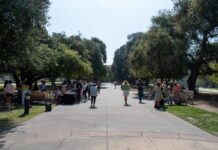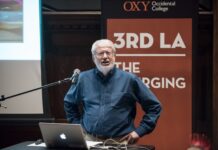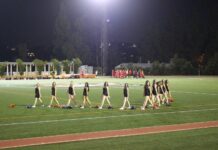Author: Alex Nieves
Search continues for most viable tenant as AEG eyes 2016 stadium completion
The Los Angeles City Council passed a unanimous vote on a plan to build a new football stadium in L.A. on Oct. 3.
Now, the city is only one step away from once again being the home to an NFL franchise. With plans to construct Farmers Field, a multi-billion dollar venue in downtown L.A. solidified, the only obstacle left is convincing a team that a move to L.A. is worth the investment.
This is an obstacle that the Anschutz Entertainment Group, the group spearheading the Farmers Field project, believes that it can overcome as early as March 2013.
L.A. is one of the of the largest and most successful media markets in the United States, reaching an estimated total of over 16 million people a year.
With seven professional sports teams that have a combined value of just under $3.4 billion, L.A. is also one of the most lucrative sports cities in the world.
However, the most successful of all American sports leagues, the National Football League, has not had a franchise in L.A. for over 18 years.
For many NFL franchises, the opportunity to call Southern California home would be an incredible enticing proposition, but there are a few scenarios that stand out as the most likely to occur.
The Buffalo Bills and the Jacksonville Jaguars are in two of the league’s smallest media markets and their images could greatly use the increased visibility that would come from a move to L.A..
While a move from Buffalo seems unlikely for the Bills, as their ownership has strong ties to western New York, a Jaguars move would make sense for both the NFL and the franchise, as the market for the team in Jacksonville is collapsing and the new ownership has little connection to the city.
The next option would come from franchises already within the state of California.
Both the Oakland Raiders and the San Diego Chargers are nearing the end of leasing deals with their outdated stadiums and neither city has prepared proposals to improve these venues or build a new stadium. While both teams would greatly benefit from a move to L.A., it is far more likely that the Chargers could find themselves relocating up the I-5.
The Chargers ownership has been in serious talks with the City of L.A. about relocation in the past. Also, L.A. leadership will be unlikely to welcome back the Raiders, whose players and fans have been a major influence on L.A. gang activity and motivated the the franchise’s move north after the 1994 season.
The league could also look at expanding to 34 teams with either two teams in L.A. or one team in L.A. and the other in San Antonio, the second largest market without an NFL franchise.
While the NFL definitely has the resources for successful expansion, this would throw off the league’s seemingly perfect 32 team format with eight equal divisions consisting of four teams. However, the league has played with uneven divisions before.
For instance, there were 31 teams for the 1999 season, so it would not be a stretch to imagine league management deciding that the profits of expansion outweigh having two uneven divisions.
The agreement to build Farmers Field has came after over a year of negotiations and competition between the AEG backed investment group and the another group of billionaire developer Ed Roski Jr., which proposed a state-of-the-art venue in the City of Industry.
For the members of the L.A. City Council and Mayor Antonio Villaraigosa, The AEG plan, which also plans to improve the Convention Center and surrounding area, offered a great opportunity to revitalize the beleaguered downtown area.
“This is not just about football,’’ Villaraigosa said in an interview with the L.A. Times. “People will come to downtown from every part of the city.”
Whatever franchise finds itself in L.A., it is likely that the new team will start play in L.A. before Farmers Field’s target date of completion in 2016.
The team will have to play in one of the two historic L.A. football stadiums, the Rose Bowl and the L.A. Coliseum, which are currently the homes of the UCLA and USC football programs respectively, before moving into Farmers Field full time.
This article has been archived, for more requests please contact us via the support system.
![]()



































